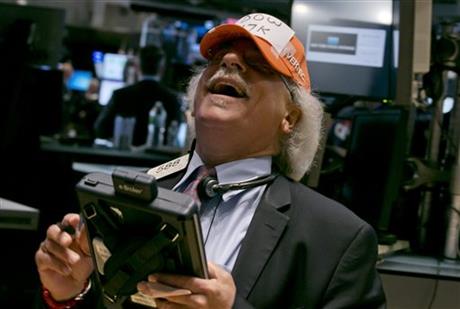WASHINGTON (AP) — How does the U.S. economy do it?

Europe is floundering. China faces slower growth. Japan is struggling to sustain tentative gains.
Yet the U.S. job market is humming, and the pace of economic growth is steadily rising. Five full years after a devastating recession officially ended, the economy is finally showing the vigor that Americans have long awaited.
Last month, employers added 288,000 jobs and helped reduce the unemployment rate to 6.1 percent, the lowest since September 2008. June capped a five-month stretch of 200,000-plus job gains — the first in nearly 15 years.
After having shrunk at a 2.9 percent annual rate from January through March — largely because of a brutal winter — the U.S. economy is expected to grow at a healthy 3 percent pace the rest of the year.
Here are five reasons the United States is outpacing other major economies:
AN AGGRESSIVE CENTRAL BANK
The Federal Reserve acted sooner and more aggressively than other central banks in keeping rates low, says Bernard Baumohl, chief global economist at the Economic Outlook Group.
In December 2008, the Fed slashed short-term interest rates to near zero and has kept them there. Ultra-low loan rates have made it easier for individuals and businesses to borrow and spend. The Fed also launched three bond-buying programs meant to reduce long-term rates.
By contrast, the European Central Bank has been slower to respond to signs of economic distress among the 18 nations that share the euro currency. The ECB actually raised rates in 2011 — the same year the eurozone sank back into recession.
It’s worth keeping in mind that the Fed has two mandates: To keep prices stable and to maximize employment. The ECB has just one mandate: To guard against high inflation. The Fed was led during and after the Great Recession by Ben Bernanke, a student of the Great Depression who was determined to avoid a repeat of the 1930s’ economic collapse.
Janet Yellen, who succeeded Bernanke as Fed chair this year, has continued his emphasis on nursing the U.S. economy back to health after the recession of 2007-2009 with the help of historically low rates.
STRONGER BANKS
The United States moved faster than Europe to restore its banks’ health after the financial crisis of 2008-2009. The U.S. government bailed out the financial system and subjected big banks to stress tests in 2009 to reveal their financial strength. By showing the banks to be surprisingly healthy, the stress tests helped restore confidence in the U.S. financial system.
Banks gradually started lending again. European banks are only now undergoing stress tests, and the results won’t be out until fall. In the meantime, Europe’s banks lack confidence. They fear that other banks are holding too many bad loans and that Europe is vulnerable to another crisis. So they aren’t lending much.
In the United States, overall bank lending is up nearly 4 percent in the past year. Lending to business has jumped 10 percent.
In the eurozone, lending has dropped 3.7 percent overall, according to figures from the Institute of International Finance. Lending to business is off 2.5 percent. (The U.S. figures are for the year ending in mid-June; the European figures are from May.)
A MORE FLEXIBLE ECONOMY
Economists say Japan and Europe need to undertake reforms to make their economies more flexible — more, in other words, like America’s.
Europe needs to lift wage restrictions that prevent employers from cutting pay (rather than eliminating jobs) when times are bad. It could also rethink welfare and retirement programs that discourage people from working and dismantle policies that protect favored businesses and block innovative newcomers, the Organization for Economic Cooperation and Development has argued.
Prime Minister Shinzo Abe has proposed reforms meant to make the Japanese economy more competitive. He wants to expand child care so more women can work, replace small inefficient farms with more large-scale commercial farms and allow more foreign migrant workers to fill labor shortages in areas such as nursing and construction.
Yet his proposals face fierce opposition.
Europe and Japan remain less well-positioned for durable long-term growth, as they have only recently begun to tackle their deep-rooted structural problems, and a lot remains to be done, says Eswar Prasad, a professor of trade policy at Cornell University.
China is struggling to manage a transition from an economy based on exports and often wasteful investment in real estate and factories to a sturdier but likely slower-growing economy based on more consumer spending.
LESS BUDGET-CUTTING
Weighed down by debt, many European countries took an ax to swelling budget deficits. They slashed pension benefits, raised taxes and cut civil servants’ wages. The cuts devastated several European economies. They led to 27 percent unemployment in Greece, 14 percent in Portugal and 25 percent in Spain. The United States has done some budget cutting, too, and raised taxes. But U.S. austerity hasn’t been anywhere near as harsh.
A ROARING STOCK MARKET
The Fed’s easy-money policies ignited a world-beating U.S. stock market rally. Over the past five years, U.S. stocks have easily outpaced shares in Europe, Japan and Hong Kong. That was one of Bernanke’s goals in lowering rates. He figured that miserly fixed-income rates would nudge investors into stocks in search of higher returns. Higher stock prices would then make Americans feel more confident and more willing to spend — the so-called wealth effect.
Most economists agree it’s worked.





